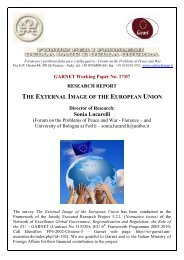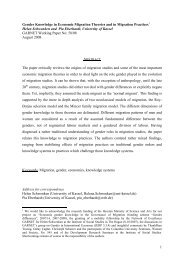GARNET Working Paper No. 13/07
GARNET Working Paper No. 13/07
GARNET Working Paper No. 13/07
You also want an ePaper? Increase the reach of your titles
YUMPU automatically turns print PDFs into web optimized ePapers that Google loves.
quarreled and configured their security in relation to one another, since their size and capacity<br />
to export violence was minimal, this security complex would have a limited geographic<br />
importance. In Middle Age Europe, for example, war resembled banditry or ‘private’ warfare<br />
with members of the military caste of knights raiding one another’s lands and creating<br />
general insecurity (Keegan, 1993).<br />
The Westphalian era saw the advent of the sovereign state, which paved the way for a<br />
profound alteration of this configuration. First, the centralization of authority and the<br />
demarcation between ‘crime’ and ‘war’ accompanied a growing recognition of a distinction<br />
between ‘inside’ and ‘outside’ the state, which consequently militated in favor of the state<br />
capacity to mobilize resources and, therefore, to wage war. And as security is a concept that<br />
involves a relationship between at least two agents, the formation and consolidation of states<br />
led to a securitization process that encompassed neighboring countries <strong>13</strong> . The increase in size<br />
of the possible producers of and receivers of threats 14 (from feuds to states), the development<br />
of new warfare equipment (introduction of gunpowder 15 ), and the permanent settlement of<br />
those agents (from nomadic tribes to sedentary states) led to the regionalization of security.<br />
At early stages, even if security, in some cases, had a primarily bilateral component (e.g.<br />
Portugal vs. Spain), the multiplication of several bilateral security relations (e.g. Portugal<br />
alliance with England to deter Spain) led to a complex net of relations that ultimately<br />
increased the territorial stage where security was formulated. When states started to play out<br />
their security strategies vis-à-vis other states, regions of security emerged. This seems to be<br />
the underlying idea expressed by Buzan et al. that ‘threats travel more easily over short<br />
distances than over longer ones” (1998:11). As I pointed out before, this is in fact a premise<br />
that should be extracted from the concept of ‘spatial diffusion’, which suggests that states in<br />
regions marked by militarized disputes and insecurity are themselves likely to experience<br />
<strong>13</strong> In order to centralize attention and to maintain intellectual coherence and cohesiveness, this article will not investigate<br />
whether the threats produced by one agent are subject to either a subjective or objective reception by the other agent. Even<br />
though I tend to agree with the idea that “securitization, like politicization has to be understood as an essential intersubjective<br />
process” (Buzan, Wæver, and de Wilde, 1998:30), the focus is on the mobility and geographical scope of threats<br />
and not on the social construction of threats. Within the spirit of this study, all threats – perceived or objective – imply a<br />
relationship between at least two actors, which has necessarily to occur at a spatial level of analysis. The examination of how<br />
these threats cluster at the regional level is part of the research agenda of this study.<br />
14 Previously ‘threat’ was defined as an action that conveys a conditional commitment to punish unless one’s demands are<br />
met. This study assumes that threats can be of a military, political, social, economic, or environmental nature. Even though a<br />
rigid distinction between the different threats is not done, the study will give priority to the production, handling and<br />
reception of military and political threats. Likewise, Lake and Morgan alert that “when threats arise from more sources, take<br />
a great variety of forms, and involve change along many dimensions, measurement and analysis become much more<br />
difficult” (1997:22).<br />
15 The period from the fifteenth to the seventeenth centuries saw widespread development in gunpowder technology mainly<br />
in Europe. Advances in metallurgy led to portable weapons and the development of hand-held firearms such as muskets.<br />
16





